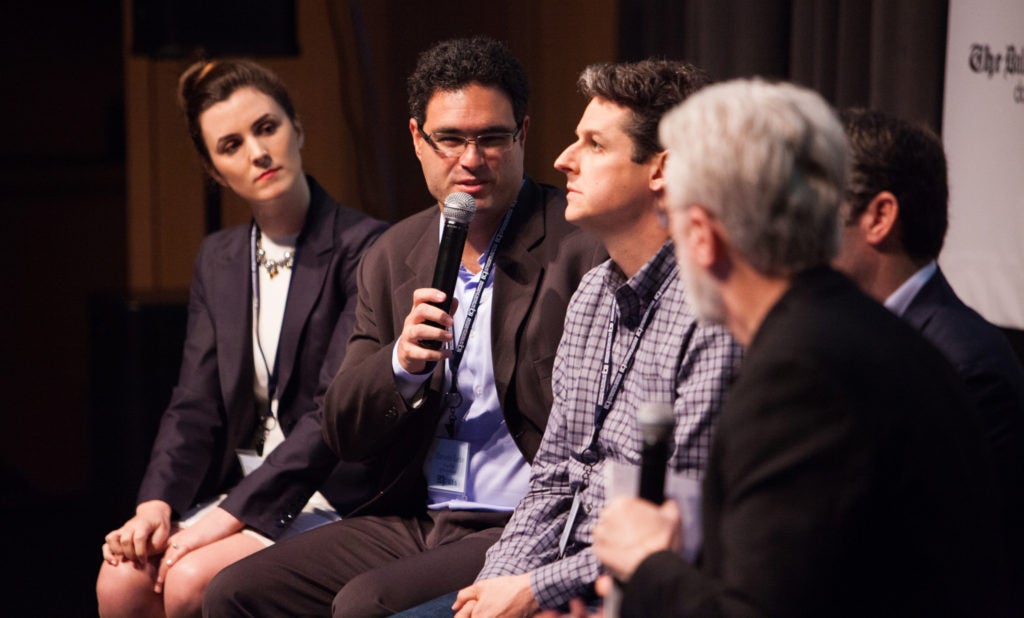April 15, 2016 | Revenue
Advertising is still relevant, multiple revenue sources are key and ad blocking is a concern, say news executives at ISOJ
Executives from a variety of media organizations told the audience at the 17thInternational Symposium on Online Journalism (ISOJ) on Friday, April 15, that advertising can still subsidize journalism, multiple revenue streams are necessary and that ad blocking is a major concern but could also be an opportunity.
As chair, Jeff Jarvis, professor and director of the Tow-Knight Center for Entrepreneurial Journalism, CUNY, opened the panel by stating that it’s in the public’s interest that journalism must be profitable, it must be a business and one key aspect of that is advertising.
Although he considers online ads to be overused, Jarvis said there are still advertisers who want to talk to potential customers and publishers have to find a way to do this. He explained that journalism’s future is based on relations of trust with consumers, and advertising needs to be “re-invented.”

Jed Hartman, chief revenue officer of The Washington Post, used the analogy of a bucket to represent newspaper revenue. In order to cover the “holes” punctured by, for example, the decline of newspaper and digital display advertising, fraud, viewability rules and ad blocking, the company has to start from scratch every day to diversify its revenue. Helping to fill the revenue bucket are efforts in areas such as social media, licensing, sponsorship, technology and experimentation.
According to Jason Kint, CEO of Digital Content Next (formerly the Online Publishers Association), a good ad has a direct trusted relationship with consumers. Trust is an expectation of value, and when the consumer expects something publishers have to give back.
Since trust in digital advertising is low, Kint said the news industry has to assume there is a loss of consumer trust, and news outlets have to do something to improve consumers’ experience.
“Think about the audience as an opportunity: there are 45 million of people using ad blockers,” Kint said. They all want quality journalism and quality entertainment. “If you offer [it] to them, they will accept your terms.”
While the panelists appeared to agree that ad blocking is here to stay, there also seemed to be a consensus that news websites are in part responsible for the rise of ad blocking because of the economic need to present as many ads as possible online, slowing down web page uploads
However, Hartman from The Washington Post insisted that ad blocking “hurts consumers” because revenue for public service journalism is impacted.

Marcelo Leite, director of product and marketing for RBS Media Group in Brazil, differed slightly with Jarvis, saying advertising is not necessarily the prime source of revenue.
Instead of trying to adapt newspapers to digital consumers, Leite said RBS crafted a plan to help people afford a new tablet that features RBS content, and eventually sell those readers a subscription. He said this effort created more profitability than traditional advertising.
Diane Vickroy, vice-president of business development of Secret Media, explained that for the average online article, 80 percent of the bandwidth is consumed by advertising. The first priority of the news publishers should be to reach people in a good way, in the sense that ads can also be informative and entertaining.
For Vickroy, the market needs to focus on combining the user’s news and advertising experiences.
ISOJ continues on Friday and Saturday in the Blanton Museum of Art, on the campus of the University of Texas at Austin, and is being livestreamed in English here and in Spanish here.
ISOJ 2016: Can Advertising Still Subsidize Journalism? Panel, from Knight Center on Vimeo.

